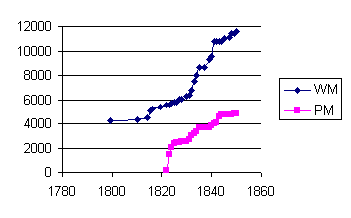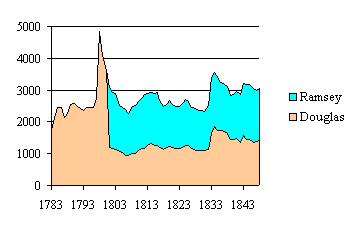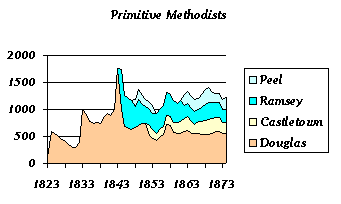
[note this page forms a slightly updated section of my paper delivered to Manx Methodist Historical Society AGM, Nov 1998 - see index for other sections and actual returns]
Estimated number in congregations (largest + 0.5 second + 0.33 third)
|
CofE |
WM |
PM |
RC |
Pres |
Cong |
|
|
Castletown |
562 |
249 |
401 |
183 |
||
|
Douglas |
3135 |
1197 |
1600 |
640 |
190 |
105 |
|
Peel |
350 |
430 |
386 |
[100] |
|
|
|
Ramsey |
945 |
646 |
130 |
81 |
|
|
|
Andreas |
413 |
593 |
0 |
|
|
|
|
Arbory |
207 |
61 |
139 |
|
|
|
|
Ballaugh |
181 |
248 |
237 |
|
|
|
|
Braddan |
441 |
226 |
250 |
|
|
|
|
Bride |
38 |
158 |
210 |
|
|
|
|
German |
385 |
259 |
66 |
|
|
|
|
Jurby |
80 |
294 |
0 |
|
|
|
|
Lezayre |
298 |
204 |
168 |
|
|
|
|
Lonan |
207 |
280 |
555 |
|
|
|
|
Malew |
681 |
368 |
175 |
|
|
|
|
Marown |
73 |
134 |
141 |
|
|
|
|
Maughold |
65 |
307 |
245 |
|
|
|
|
Michael |
292 |
322 |
274 |
|
|
|
|
Onchan |
445 |
298 |
60 |
|
|
|
|
Patrick |
231 |
587 |
94 |
|
|
|
|
Rushen |
545 |
443 |
314 |
|
|
|
|
Santan |
91 |
90 |
93 |
|
|
|
|
|
7317 |
5538 |
943 |
271 |
105 |
|
IA (% of weighted popn) |
PC (% share) |
|||||
|
CofE |
WM |
PM |
CofE |
WM |
PM |
|
|
Castletown |
32 |
14 |
23 |
40 |
18 |
29 |
|
Douglas |
45 |
17 |
23 |
43 |
15 |
25 |
|
Peel |
21 |
26 |
24 |
28 |
34 |
30 |
|
Ramsey |
50 |
34 |
7 |
52 |
36 |
7 |
|
Andreas |
27 |
39 |
- |
41 |
59 |
0 |
|
Arbory |
19 |
5 |
12 |
51 |
15 |
34 |
|
Ballaugh |
19 |
25 |
24 |
27 |
37 |
36 |
|
Braddan |
26 |
13 |
15 |
48 |
25 |
27 |
|
Bride |
5 |
21 |
28 |
9 |
39 |
52 |
|
German |
25 |
17 |
4 |
54 |
36 |
9 |
|
Jurby |
12 |
43 |
- |
21 |
79 |
0 |
|
Lezayre |
17 |
12 |
10 |
44 |
30 |
25 |
|
Lonan |
11 |
15 |
30 |
20 |
27 |
53 |
|
Malew |
30 |
16 |
8 |
56 |
30 |
14 |
|
Marown |
8 |
14 |
15 |
21 |
39 |
41 |
|
Maughold |
5 |
25 |
20 |
11 |
50 |
40 |
|
Michael |
29 |
32 |
28 |
33 |
36 |
31 |
|
Onchan |
19 |
13 |
3 |
55 |
37 |
7 |
|
Patrick |
11 |
29 |
5 |
25 |
64 |
10 |
|
Rushen |
24 |
19 |
14 |
42 |
34 |
24 |
|
Santan |
18 |
18 |
19 |
33 |
33 |
34 |
|
26 |
20 |
15 |
39 |
31 |
23 |
|
Detailed returns from parishes and towns are given in an appendix.
Those of the Established Church seem to be complete except for St Thomas's, Douglas ,which had been opened (licensed but not consecrated) in 1849, however the first curate Rev. W. Carter left early in 1851 and his successor, Rev S. Simpson was in charge from May 1851 so possibly there was no service that Sunday. However a search through the Mona's Herald of the period failed to find any mention of a closure The dispute which was to close St Thomas for many years did not come about until 1867.
Those of the Roman Catholic community would appear to be included (I have included the estimated congregation at Peel as it would appear that services were not held every Sunday and it is unlikely they would have journeyed to Douglas).
The Athol Street Congregational or Independent Chapel is missing from the returns; according to Nightingale the Rev Stallybrass had been installed as Minister the previous year. Stallybrass is included in the population census of that night which shows him aged 31 and described as Independent Minister (born in Siberia to a missionary father) living next door to Rev John Hill in Stanley Terrace.
The main question mark must hang over the numerous Methodist Chapels and especially house meetings. A Circuit Plan for the Wesleyan Methodist Douglas and Castletown circuit covering the census date still survives [MM E240/plans] as does a copy of Y Phlan Beg 1 for the same circuit. Unfortunately no plan for the Ramsey/Peel circuit or for the Primitive Methodist circuits are extant.
Rosser [1848] gives a
List of chapels and other preaching places in the Douglas and Castletown, and Ramsey and Peel, circuits, respectively, as published on the preachers' double plan for May, June, and July, 1848.
The letter before the name serves to describe the preaching place: c denoting chapel; s school house; r room; and h private house.
I have marked on the list those missing from the 1851 plan and whether they appear or not on the census returns ('+' or X). The times of services are taken from the Plan of the Douglas/Castletown circuit including March 30; those for Peel/Ramsey are from an 1848 plan in the John Rylands Library2. Not Planned indicates that no service was planned for census Sunday - the 'shall be supplied' on the plan may indicate that a service was doubtful.
.
|
Douglas and Castletown |
|
|
c Thomas street (+ 8am , 11am , 3pm 6pm) |
h Ballashamrock. (3pm) XX |
|
c Well road ( + 11am 6pm) |
h John Kermode's (not on 1851 plan). |
|
c Crosby (+ 11am, 6pm) |
s Cloven Stones. (+ 6pm) |
|
c Baldwin (+ 2.30pm, 6pm) |
c Castletown. (+ 11am, 6pm) |
|
s East Baldwin (+ 2.30pm) |
c Colby. (+ 2pm, 6pm) |
|
c Cooile (+ 2.30pm) |
c Port St. Mary (+ 2pm, 6pm). |
|
s Union Mills. (6pm) XX |
c Kirk St. Ann. (+ 3pm, 6pm) |
|
c Kirk Lonan. (+ 2.30, 6pm) |
c Ballasalla. (+ 3pm, 6pm) |
|
c Kirk Onchan. (+ 2.30pm 6pm) |
c Kerrowkiel (+ 2pm, 6.30pm) |
|
c Ballakilmerton. (+ 3pm, 6pm) |
c Howe. (+ 2pm, 6.30pm) |
|
h Ballamoar. (2pm) not planned |
c Ballafesson. (+ 2.30pm, 6pm) |
|
h John Kewley's. (2pm) shall be supplied |
r Ballabeg (2pm) XX. |
|
c Laxey.(+ 11am, 6pm) |
c Ballagarey. (+ 2.30pm) |
|
c Abbey Lands.(+ 10.45am) |
c Ballamoda. (+ 2pm) |
|
h Clepts. (3pm) XX |
c Ballakilpheric. (+ 2pm) |
|
s Cold Clay (6pm)XX. |
h Poolvash. (2pm ) not planned |
|
h Ballacowin. (10.30, 2pm) XX |
h Richard Kelly's. (2pm) XX |
|
h Glen Roy (2pm) XX |
h Ary Stein (2pm) not planned |
|
Ramsey and Peel. |
|
|
c Ramsey (+ 10.30am, 3pm, 6pm) |
c Dhoor. (+ 2.30pm, 6pm) (in 1848 alternate weeks with Gery) |
|
c Peel (+ 10.30am, 6pm) |
c Geary. (+ 2.30pm, 6pm)+ |
|
c Ballakaneen.(+ 9.15am, 6pm) |
c Port-a-Vullin. + |
|
c Sulby. (+ 2.30pm, 6pm) |
c Ballajorey. (+ 2.30pm, 6pm) |
|
c Kerrowgarrow (+ 3pm, 6pm) |
c Cardle (+ 2.30pm, 6pm) |
|
r Regaby (+ 2.30pm alt weeks)(no service) |
c Kirk Michael (+ 2.30pm, 6pm) |
|
c Glasgow. X(10.30am, 2.30pm, 6pm) |
c Barregarrow (+ 2.30pm, 6pm) |
|
c Kirk Bride. (+ 3pm, 6pm) |
c Lambfell (+ 2.30pm) |
|
c Smeal. (+ 2.30pm, 6pm) |
c Kerrowglass (+ 2.30pm) |
|
c Lhen Mooar (+ 2.30pm, 6pm) |
c Little London (+ 10am alternate weeks) |
|
c Jurby East. (+ 2.30pm, 6pm) |
c Lhergydhoo (+ 2.30pm, 6pm alternate weeks) |
|
c Jurby West (+ 2pm, 6pm) |
c St Johns (+ 6pm) |
|
c Ballaugh (+ 2pm, 6pm) |
h kenna X (6pm once per month) |
|
c Ballaugh new chapel. (+ 3pm, 6pm) |
c Greeba (+ 2.30pm) |
|
c Ballaugh curragh (+ 6pm) |
c Foxdale (+ 2.30pm) |
|
c Close Ballaskella. X (2pm) |
c Dawby (+ 2pm) |
|
c Glenoldin. (+ 3pm) |
c Gordon (+ 2pm, 6pm |
|
s Sandy Gate. (+ 3pm, 6pm) |
c Glen Rushen (+ 2pm, 6pm |
Definitely missing is any return are from Glasgow (Glascoe) and Union Mills (held in School room ) there is a return from the Independent (Congregational) Sunday School run by Dalrymple. Six (6) Planned house meetings in the Douglas circuit also do not have any return.
On 'Y Phlan Beg' (mainly mid week house meetings) as compared with the circuit Plan for that period there are apparently the following Sunday services
Ballafesson 6pm (same time as Plan but different preacher)
Howe (returns show the 2 Planned services),
Ballakilpheric, (returns show the 2 Planned services)
Strandhall (6pm - not on Plan)
Ballabeg (already noted as missing),
Ery Stein (not on Plan)
Ronague and Ronague school house,
Kerrowkeil (2 services appear as per Plan),
Ballamoda (the 6.30pm is presumably the Phlan Beg),
Ballagary (the 2.30pm is Planned possibly the 6pm is the Plan Beg),
Grenaby
John Cottiers (a house meeting).
So it is possible that several other House Meetings were missed either by the enumerators or possibly ignored by the person who put together the manuscript lists which have survived.
Returns
The lowest PC for any established Church is the 9% of Bride - as both the WM and the PM chapels are within 50m of the church the weather and distance cannot be the reason. Gelling notes that Rector Nelson's father who died in 1847 after 17 years in the Parish, was noted as a Tractarian - it is possible that he was so out of touch with the evangelical parishioners that they deserted the Established Church. In 1872 there was considerable parish disquiet at the cost of building the new church and some three years later on the death of Rector Nelson the parish petitioned for a ex-Methodist to be appointed. The Primitives slightly outnumber the Wesleyans.
The next lowest is Maughold with 11% - here the average congregation is not noted as much more than the actual congregation so again weather cannot be to blame. Maughold church is certainly isolated and a considerable distance from most parishioners. St Paul's in Ramsey will have taken many from that part of the parish; the later Dhoon chapel would ease distances in the south of the parish. Wesleyans slightly outnumber Primitive Methodists.
The established church is strongest in the towns, except for Peel, Ramsey (52%) Douglas (43%) and the south - Castletown, Arbory, Malew and Rushen are all over 40% . Only in Jurby is there a stronger Wesleyan share than that of the established church.
There are five parishes Andreas (0%), Jurby (0%), Onchan (7%), German (9%), Patrick (10%) and Ramsey (7%) where the Primitive Methodists is 10% or below.
Daniel Mylrea had been rector of Andreas from 1814-1837, much loved and had never raised the tithes. Problems with the tithe had been a major component of disquiet with the Established church in the 1820's when the Prims were establishing themselves, this possibly removed a cause to desert the parish church. In Jurby I suspect a strongly established Wesleyan tradition (some 79% considerably more than any other parish) deterred the Prims.
The Primitive Methodist strength lay in Lonan and especially the mining area of Laxey - it is possible that many of the immigrant miners brought with them a radical Methodism.
Seating Provision
The following figure shows the growth of seating provision by the two Methodist communities

Membership figures for the Weslyans can be found in Rosser (up to 1848) and are plotted below:

Membership figures for the Primitive Methodists can be determined from their annual returns to Conference:

|
|
||
|
|
||
|
Any comments, errors or omissions
gratefully received The
Editor |
||